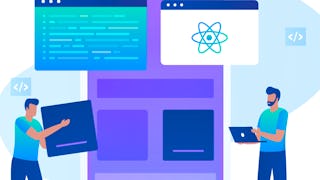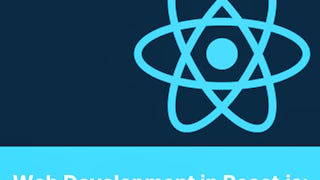A frontend application is expected to have an attractive, responsive UI and a seamless UX with swift navigable views. Single Page Applications (SPAs) fulfill these expectations as they are lighter and efficient. React, a popular JavaScript library is used for developing complex user interfaces for single page applications (SPAs). Facebook, Instagram, Netflix, Airbnb etc., are some of the famous websites that use React.

Enjoy unlimited growth with a year of Coursera Plus for $199 (regularly $399). Save now.

Building Interactive User Interfaces Using React Library
This course is part of Frontend Development using React Specialization

Instructor: NIIT
2,410 already enrolled
Included with
What you'll learn
Develop an attractive, responsive UI and a seamless UX with swift navigable views using React Class components
Skills you'll gain
Details to know

Add to your LinkedIn profile
5 assignments
See how employees at top companies are mastering in-demand skills

Build your subject-matter expertise
- Learn new concepts from industry experts
- Gain a foundational understanding of a subject or tool
- Develop job-relevant skills with hands-on projects
- Earn a shareable career certificate

There are 5 modules in this course
React element is the fundamental building block used for developing React SPAs. As a developer, you will be expected to create the stateless functional components of React using the React elements. In this learning sprint, you will explore the techniques used to render React elements conditionally, along with the techniques used to render multiple components. Hands-on practice provided during this learning sprint will enable you to add React to the existing websites and create functional components using the React elements.
What's included
13 videos2 readings1 assignment1 programming assignment
Interactive React web pages require stateful components to manage their own state which can be even pass down to its child components using props. As a developer, you will be required to create stateful components to accept user inputs, to add elements which are interactive and fetch data before rendering. In this learning sprint , you will learn to create React class components and manage state by handling events. You will explore the concept of virtual DOM and reconciliation. Hands-on practice will help you to build stateful class components with better code readability using JSX syntax.
What's included
12 videos1 reading1 assignment1 programming assignment
Single Page Applications created on component-based-approach scales well as the components can be reused. While developing an SPA, the first step is to identify components and build its hierarchy. As a front-end developer, you will be required to identify and create reusable components for the React web application. In this learning sprint, you will explore the principles required to break down a user interface into a component hierarchy. You will also learn how to share data between multiple components. Hands-on practice will help you to acquire skills to create React projects quickly using the create-react-app tool which offers a modern build setup with no configuration.
What's included
16 videos1 reading1 assignment2 programming assignments
State management is a complex process that requires clear understanding of a component’s life cycle. To efficiently manage state at various phases in the life of component, a front-end developer is expected to have skills to work effortlessly with the life cycle methods of the React component. In this learning sprint, you will learn about the different life cycle methods that help monitor and manipulate the React class components. Hands-on exercises provided with this sprint enables you to manage the component state while fetching data from the server and to handle the JavaScript errors.
What's included
13 videos1 reading1 assignment2 programming assignments
Testing is an integral process of development as it helps in identifying defects/bugs during the early stages of development. Unit testing involves testing of individual components of the software program or application. As a React developer, the components should be adequately tested for correctness, completeness and performance. In this learning sprint, you will learn to write test code for testing React class components using Jest framework. Hands-on exercises of this sprint will help you to explore common testing patterns for writing test codes. The exercises will enable you to write test cases for various state management scenarios.
What's included
18 videos1 reading1 assignment1 programming assignment
Earn a career certificate
Add this credential to your LinkedIn profile, resume, or CV. Share it on social media and in your performance review.
Explore more from Mobile and Web Development
 Status: Free Trial
Status: Free Trial Status: Free Trial
Status: Free Trial Status: Free Trial
Status: Free TrialBoard Infinity
Why people choose Coursera for their career





Open new doors with Coursera Plus
Unlimited access to 10,000+ world-class courses, hands-on projects, and job-ready certificate programs - all included in your subscription
Advance your career with an online degree
Earn a degree from world-class universities - 100% online
Join over 3,400 global companies that choose Coursera for Business
Upskill your employees to excel in the digital economy
Frequently asked questions
To access the course materials, assignments and to earn a Certificate, you will need to purchase the Certificate experience when you enroll in a course. You can try a Free Trial instead, or apply for Financial Aid. The course may offer 'Full Course, No Certificate' instead. This option lets you see all course materials, submit required assessments, and get a final grade. This also means that you will not be able to purchase a Certificate experience.
When you enroll in the course, you get access to all of the courses in the Specialization, and you earn a certificate when you complete the work. Your electronic Certificate will be added to your Accomplishments page - from there, you can print your Certificate or add it to your LinkedIn profile.
Yes. In select learning programs, you can apply for financial aid or a scholarship if you can’t afford the enrollment fee. If fin aid or scholarship is available for your learning program selection, you’ll find a link to apply on the description page.
More questions
Financial aid available,


